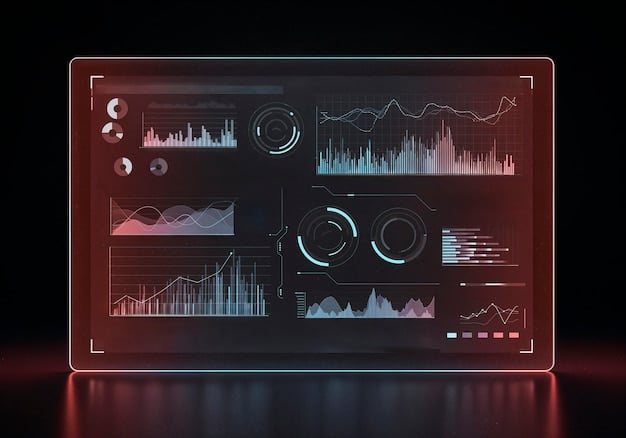The Hype Effect: Viral Trends & Consumer Behavior in 2025

The Hype Effect in 2025 describes the significant impact of viral trends, fueled by social media and digital platforms, on consumer purchasing decisions and overall behavior, creating fleeting but powerful market shifts.
Understanding the Hype Effect: Understanding How Viral Trends Impact Consumer Behavior in 2025 is crucial for businesses seeking to navigate the dynamic landscape of modern consumerism. In this article, we will explore its nuances and implications.
What is the Hype Effect?
The hype effect refers to the phenomenon where consumer interest in a particular product, service, or trend rapidly increases due to widespread attention and excitement, often fueled by social media, influencer marketing, and viral content. Understanding this effect is critical for businesses and marketers looking to capitalize on fleeting opportunities and navigate the ever-changing landscape of consumer behavior.
The hype effect isn’t simply about a product going viral; it’s about how this sudden surge in popularity translates into tangible consumer actions. It’s about the power of collective excitement and its measurable influence on purchasing decisions.
Key Characteristics of the Hype Effect
The hype effect possesses unique characteristics that distinguish it from traditional marketing or sustained consumer interest. Recognizing these traits is crucial for both leveraging and mitigating the effects of viral trends.
- Rapid Growth: Hype trends typically experience an exponential growth in popularity within a short timeframe, often driven by viral content and social media algorithms.
- Short Lifespan: Unlike established trends, hype-driven products or ideas tend to have a relatively short lifespan, with interest often waning as quickly as it spikes.
- Strong Social Influence: Social media platforms and influencers play a significant role in amplifying the hype effect, shaping consumer perceptions and driving demand.
- Emotional Connection: Hype often taps into consumers’ emotions, such as excitement, desire, or fear of missing out (FOMO), influencing purchasing decisions.
In essence, the hype effect is a powerful but often transient phenomenon. By understanding its core characteristics, businesses can be better prepared to react strategically and avoid the pitfalls of over-reliance on viral trends. This allows them to build deeper and more sustainable relationships with the consumer base.

Social Media’s Role in Amplifying Hype
Social media platforms are the primary catalysts for spreading hype, serving as the breeding ground for viral trends and shaping consumer perception. The algorithms that govern these platforms are designed to amplify content that generates engagement. This creates a feedback loop where hype trends can skyrocket in popularity within hours or even minutes.
Platforms like TikTok, Instagram, and Twitter have become the modern-day town squares where trends are born and spread. The interconnected nature of these platforms allows information to disseminate with unprecedented speed and impact.
The Algorithm Effect
Social media algorithms play a crucial role in determining which content gains traction and which remains relatively unseen. Understanding the algorithm’s preferences can be instrumental in predicting and even shaping the hype effect.
- Engagement-Based Ranking: Algorithms prioritize content that generates high levels of engagement, such as likes, shares, and comments, leading to increased visibility.
- Personalized Feeds: Targeted content based on individual preferences and browsing history further amplifies the hype effect within specific communities.
- Trending Topics: Social media platforms often feature trending topics or hashtags, creating a centralized hub for hype-driven content.
Social media influencers act as key conductors in amplifying the hype. These digital personalities often possess a devoted following and exert a significant impact on their audience’s purchasing decisions.
Consumer Psychology Behind Viral Trends
To truly understand the hype effect, it’s critical to explore the underlying psychological factors that drive consumer behavior in the face of viral trends. Several established psychological principles contribute to the allure and influence of hype.
Understanding the consumer psychology behind hype trends is paramount for businesses to craft messaging that resonates with the audience and converts fleeting interest into lasting engagement.
Key Psychological Drivers
Consumer behavior in the era of viral trends is influenced by a complex interplay of psychological drivers. Recognizing these underlying factors allows businesses to tailor their strategies and messaging for maximum impact.
- Fear of Missing Out (FOMO): This pervasive emotion drives consumers to participate in trends to avoid feeling excluded or out of touch with their social circles.
- Social Proof: Consumers often look to others for validation, and the widespread adoption of a trend serves as a powerful form of social proof, influencing their own decisions.
- Scarcity Principle: Limited availability or exclusivity associated with a hyped product can create a sense of urgency and drive demand.
- Bandwagon Effect: As a trend gains momentum, more and more people jump on the bandwagon, further fueling its popularity and influencing others to participate.
These psychological triggers may trigger impulsive purchases and brand loyalty as well. Understanding these elements is critical to anticipating consumer reactions.
Predicting the Next Big Thing in 2025
Anticipating the next viral trend is a challenging yet potentially lucrative endeavor for businesses. While the unpredictable nature of hype makes forecasting difficult, several factors can help predict emerging trends and capitalize on the hype effect.
Businesses that can accurately predict and prepare for viral trends gain a significant competitive advantage, positioning themselves to capture market share and build brand awareness.

Factors to Consider
Several factors can influence the emergence and trajectory of viral trends. Keeping a close watch on these indicators can provide valuable insights into the next big thing.
- Social Media Analytics: Monitoring trending topics, hashtags, and conversations on social media platforms can reveal early signals of emerging hype trends.
- Cultural Shifts: Identifying evolving cultural values, attitudes, and lifestyles can help anticipate the types of products or ideas that are likely to resonate with consumers.
- Technological Advancements: New technologies and platforms often create opportunities for viral trends to emerge, as seen with the rise of TikTok and short-form video content.
- Influencer Activity: Tracking the activities and endorsements of influential figures can provide clues about upcoming trends and consumer preferences.
The ability to anticipate the next viral trend empowers businesses to develop proactive marketing strategies and build relationships with individuals.
Strategies for Leveraging Hype Effectively
Successfully leveraging the hype effect involves more than simply jumping on the bandwagon. It requires a strategic approach that aligns with your brand values, target audience, and long-term business goals. Here are some key strategies for maximizing the potential of viral trends.
Effectively leveraging the hype effect can generate significant returns, but only when approached with careful planning and a clear understanding of the risks involved.
Key Strategies for Maximizing Hype
Harnessing the power of hype requires a multifaceted strategy that considers both short-term gains and long-term brand building. Focus on authenticity, value, and audience engagement.
- Authenticity and Transparency: Building trust with consumers is paramount, and authenticity should be at the core of your hype-driven campaigns. Avoid deceptive practices or misleading claims that can damage your brand reputation.
- Value-Driven Approach: Instead of solely focusing on capitalizing on the hype, consider how your product or service can genuinely provide value to consumers. Align your messaging with their needs and pain points.
- Audience Engagement: Encourage user-generated content and actively engage with your audience on social media. Create a sense of community around your brand and foster meaningful conversations.
- Adaptability and Agility: The hype effect is fleeting, so it’s crucial to remain adaptable and agile. Be prepared to adjust your strategies and messaging as the trend evolves.
Potential Pitfalls and Ethical Considerations
While the hype effect can create significant opportunities, it also presents potential pitfalls and ethical considerations. Businesses should be aware of these risks and take steps to mitigate them. Transparency, sustainability, and responsibility are crucial in navigating the hype-driven market.
A short-sighted approach to hype can damage your brand’s reputation and erode consumer trust. Ethical considerations must be at the forefront of your strategy.
Ethical Concerns to Keep in Mind
Building trust and avoiding potential pitfalls require that you keep ethical considerations in mind.
- Misleading Marketing: Avoid making exaggerated claims or using deceptive tactics to capitalize on the hype. Transparency and honesty are essential for maintaining consumer trust.
- Sustainability Concerns: The rapid consumption associated with hype trends can contribute to environmental waste and unsustainable practices. Promote responsible consumption and eco-friendly alternatives.
- Exploitation of Labor: Ensure that your supply chain adheres to ethical labor practices and avoids exploiting workers to meet the demands of hype-driven production.
- Cultural Appropriation: Be mindful of cultural sensitivities and avoid appropriating or misrepresenting cultural elements for commercial gain.
| Key Point | Brief Description |
|---|---|
| 🚀 Rapid Growth | Trends quickly gain popularity through viral content. |
| 📱 Social Media | Platforms amplify hype and shape consumer views. |
| 🧠 Consumer Psychology | FOMO and social proof drive purchasing decisions. |
| 📈 Trend Prediction | Monitor social analytics and cultural shifts. |
Frequently Asked Questions
▼
The Hype Effect refers to the amplified consumer interest in a product or trend, fueled by social media and other digital platforms, resulting in short-lived spikes in popularity and sales.
▼
Social media algorithms prioritize engaging content, pushing hyped trends to the top of feeds. Personalized content also ensures that users see trends that match their interests, further amplifying the hype.
▼
Companies should prioritize authenticity and transparency. It’s essential to ensure that your product offers actual value and doesn’t simply ride the wave of hype, risking a negative brand association.
▼
Social media analytics provides invaluable insight into monitoring conversations, new hashtags, and emerging cultural themes. Influencer endorsements also have potential to signal an upcoming trend.
▼
The Bandwagon Effect is a major element within Consumer Psychology. Also, consumers want to avoid FOMO. Combined, the two are key psychological drivers and create a powerful purchasing stimulus.
Conclusion
The hype effect presents both opportunities and challenges for businesses in 2025. By understanding the drivers of viral trends and employing ethical and strategic approaches, companies can maximize the potential of hype while minimizing the risks. Keeping authenticity, transparency, and sustainability at the core of your strategy will lay the foundation for success in the ever-evolving world of consumer behavior.






